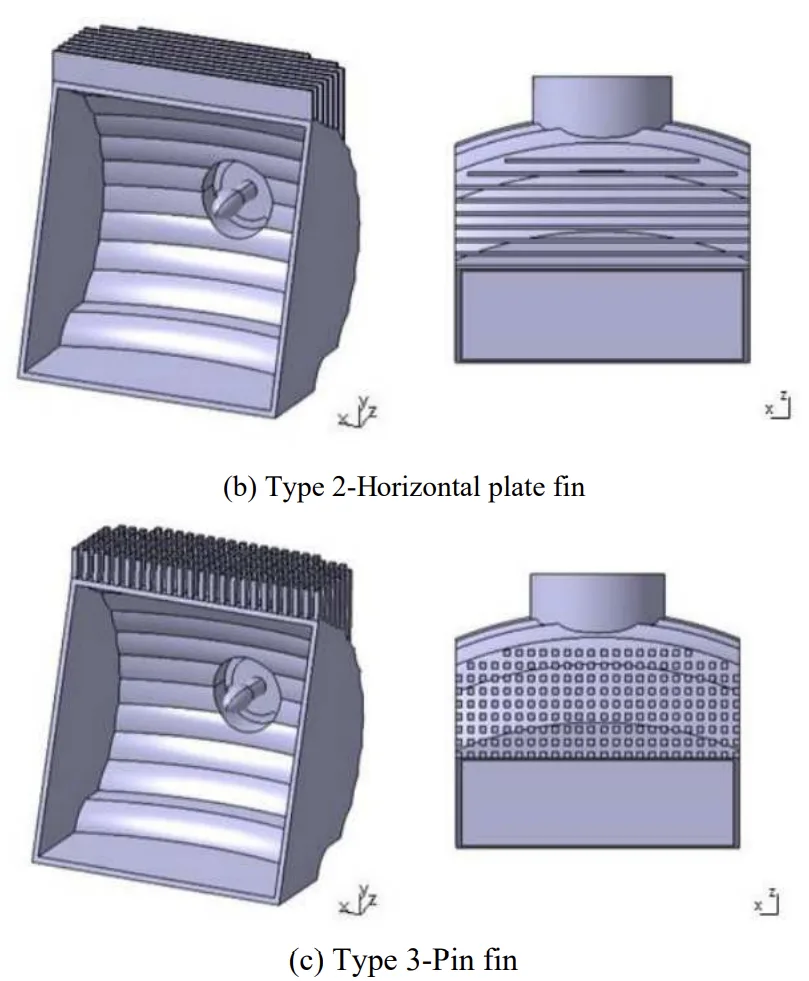This article introduces the paper "OPTIMAL PLATE-FIN DESIGN FOR IMPROVING HEAT DISSIPATION PERFORMANCE OF AUTOMOBILE LAMP REFLECTORS".
1. Overview:
- Title: OPTIMAL PLATE-FIN DESIGN FOR IMPROVING HEAT DISSIPATION PERFORMANCE OF AUTOMOBILE LAMP REFLECTORS
- Authors: Young Shin Kim, Seung Jun Na, Euy Sik Jeon
- Year: 2019
- Journal/Conference: International Journal of Mechanical Engineering and Technology (IJMET)
- Keywords: Optimal design, Plate-fin, Heat dissipation, Lamp reflector
2. Research Background:
Automobile headlamp reflectors experience high temperatures due to heat generated by the lamp and their sealed structure. These high temperatures reduce light output and shorten lamp lifespan, potentially causing thermal shock deformation in nearby components. While previous research has investigated various aspects of LED lamp design and heat dissipation, including heat sink shapes, fin arrangements, and fin dimensions, there's a lack of focused research on optimal fin design specifically for improving reflector heat dissipation performance. This study aims to address this gap.
3. Research Objectives and Questions:
- Research Objective: To develop an optimal plate-fin design for enhancing the heat dissipation performance of automobile lamp reflectors.
- Key Research Questions: What fin type most effectively improves headlamp reflector heat dissipation? What are the optimal dimensions for this fin type?
- Research Hypothesis: A vertical plate-fin design will outperform existing reflectors and further performance improvements are achievable through dimensional optimization.
4. Methodology:
- Research Design: A three-dimensional (3D) heat flow analysis was conducted using ANSYS Fluent to compare the heat transfer performance of an existing reflector with three different radiating fin types: vertical plate-fin, horizontal plate-fin, and pin-fin. The validity of the analytical model was verified by comparing simulation results with experimental temperature measurements from an existing reflector. Subsequently, design of experiments (DOE) using the Box-Behnken method was employed to optimize the dimensions of the best-performing fin type.
- Data Collection: Experimental temperature data were collected from an existing reflector under operating conditions. Simulation data were obtained using ANSYS Fluent for various fin designs.
- Analysis Methods: 3D heat flow analysis (ANSYS Fluent), comparison of experimental and simulation results, ANOVA, regression analysis, response surface methodology (RSM), optimization techniques.
- Subjects and Scope: Automobile lamp reflector, three types of radiating fins (vertical plate, horizontal plate, pin), dimensional optimization using the Box-Behnken design.
5. Main Research Findings:
- Key Findings: Vertical plate-fins demonstrated superior heat dissipation performance compared to horizontal plate-fins and pin-fins. Optimization using the Box-Behnken DOE resulted in a 4.5% improvement in heat dissipation performance relative to the existing reflector model. Optimal fin dimensions were determined as: height (h) = 8 mm, thickness (t) = 0.8 mm, and number (n) = 30.
- Statistical/Qualitative Analysis Results: ANOVA revealed that fin thickness, height, and number significantly impacted heat dissipation. A regression equation was derived to predict temperature based on these variables. Residual analysis confirmed model validity.
- Data Interpretation: Simulation results were validated against experimental data. The superior performance of vertical plate-fins was established through a comparative analysis. Optimization using DOE yielded a quantifiable improvement in heat dissipation.
- Figure List: (Due to OCR limitations, detailed descriptions are unavailable. Figures depicted various simulations, experimental setups, results comparisons, and optimization analyses.) Figures included simulated boundary conditions, schematic diagrams of the experimental setup, temperature comparisons, reflector models with different fin types, and optimization results.
- Figure 1: Simulated boundary conditions
- Figure 2: Schematic diagram of the experimental setup
- Figure 3: Reflector heat dissipation experiment setup
- Figure 4: Comparison of experimental and simulation results
- Figure 5: Reflector models with three types of radiating fins (vertical plate, horizontal plate, and pin fins)
- Figure 6: Maximum temperature of each reflector model type
- Figure 7: Rotated diagrams of the vertically installed fins
- Figure 8: Main effects plot showing the effect of fin height (h), thickness (t), and number (n) on temperature
- Figure 9: Residual plots for temp. (Normal Probability Plot, Versus Fits, Histogram, Versus Order)
- Figure 10: Optimization solutions showing the optimal values of h, t, and n

6. Conclusions and Discussion:
This study successfully optimized the design of a plate-fin for improved heat dissipation in automobile lamp reflectors. Vertical plate-fins were identified as the most effective design, and Box-Behnken optimization led to a 4.5% performance enhancement. This contributes to extended lamp life and improved performance. While the study employed rigorous simulation and experimental validation, it acknowledges limitations in fully representing the complexities of a real-world headlamp environment.
7. Future Research:
Future research should consider extending the optimal design to various reflector types and validating the findings under diverse operating conditions. Further investigation could explore different materials and manufacturing processes for fin construction. Additional testing under a wider range of lamp power outputs and driving scenarios is recommended.
8. References Summary:
Copyright: This summary is based on the paper: OPTIMAL PLATE-FIN DESIGN FOR IMPROVING HEAT DISSIPATION PERFORMANCE OF AUTOMOBILE LAMP REFLECTORS.
Unauthorized commercial use is prohibited.
Copyright © 2025 CASTMAN. All rights reserved.